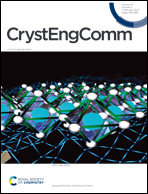Modulating the structural topologies from star-shape to cross-shape for Co–Dy heterometallic complexes with slow magnetic relaxation behavior†
Abstract
Two novel Co–Dy heterometallic complexes, namely, [CoIII2DyIII2(HL)L{(py)2CO2}{(py)2C(OCH3)O}(NO3)4CH3OH]·2CH3CN·2.5H2O (1, H3L = 2-((2-hydroxy-benzylidene)amino)propane-1,3-diol, (py)2C(OH)2 = the gem-diol form of di-2-pyridyl ketone (dpk) and (py)2C(OCH3)OH = the hemiacetal form of dpk) and [CoIII{(py)2C(OH)O}2][CoII2DyIII4DyIII(HL)4(L)4]·3CH3CN·15H2O (2), have been obtained by employing H3L, dpk and Dy(NO3)3·5H2O reacting with Co(NO3)2·6H2O or anhydrous Co(CH3CO2)2 in the solutions of CH3OH and CH3CN (V/V = 1/20) containing N(Me)4OH·5H2O or triethylamine. Structural analysis indicated that two DyIII and two CoIII in 1 formed a star-like topology, while the metal ions in [CoII2DyIII4DyIII(HL)4(L)4]− of 2 formed a cross-shaped topology, in which one DyIII and two CoII formed a linear CoII2DyIII paramagnetic unit. Interestingly, the paramagnetic CoII2DyIII units in 2 were isolated not only by four diamagnetic CoIII in the [CoII2DyIII4DyIII(HL)4(L)4]−, but also by the diamagnetic [CoIII{(py)2C(OH)O}2]+. More interestingly, the distortion of the square antiprism (SAP-8) coordination geometry of DyIII in 2 can be ascribed to the presence of four long Dy–O bonds and four short Dy–O bonds, which could result from the discrepancies of the polarization of CoII and CoIII. Magnetic studies indicated that 1 exhibit two types of magnetic relaxation behavior, in which the magnetic relaxation of the fast relaxation (FR) phase is mainly governed by QTM, while that of the slow relaxation (SR) phase is mainly governed by Orbach and Raman processes with an effective energy barrier (Ueff) value of 59.4(9) K. To our knowledge, the Ueff value is relatively high among the reported CoIII–DyIII heterometallic complexes. For 2, it only shows slow relaxation behavior with a Ueff of 6.43 K. Ab initio calculations revealed that the SR phase and FR phase are governed by the magnetic relaxation of Dy2 and Dy1, respectively, though the axial symmetry of Dy2 (muffin, Cs) is lower than that of Dy1 (triangular dodecahedron, D2d). However, for 2, the theoretical calculations indicated that the severely compressed SAP-8 geometry of DyIII leads to a relatively low Ueff value.



 Please wait while we load your content...
Please wait while we load your content...